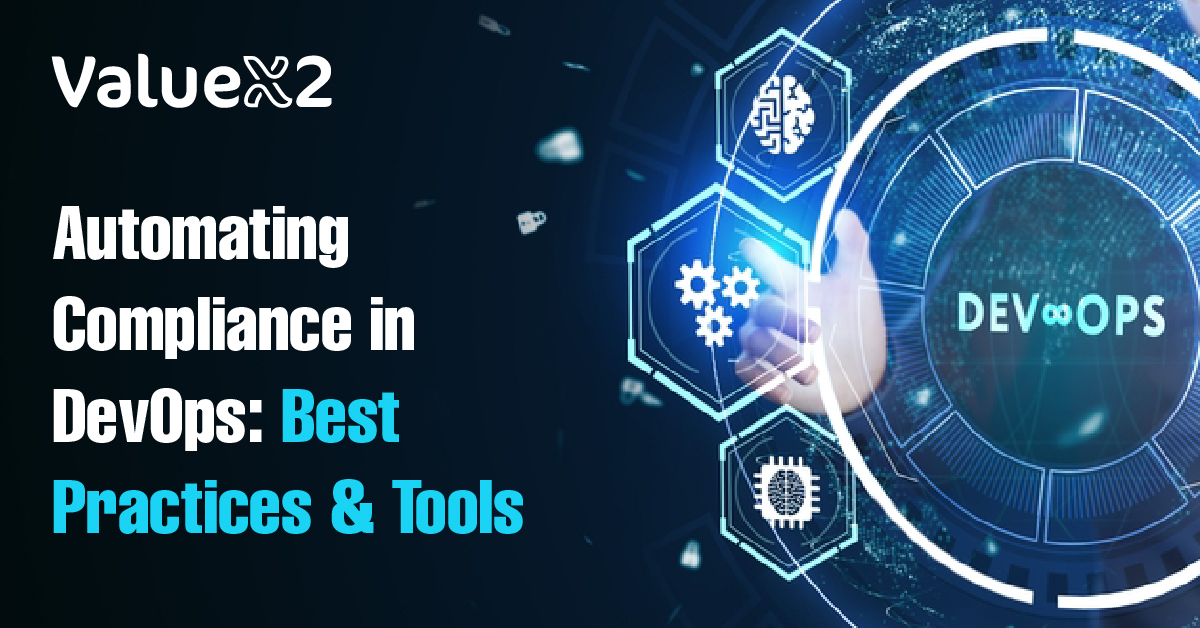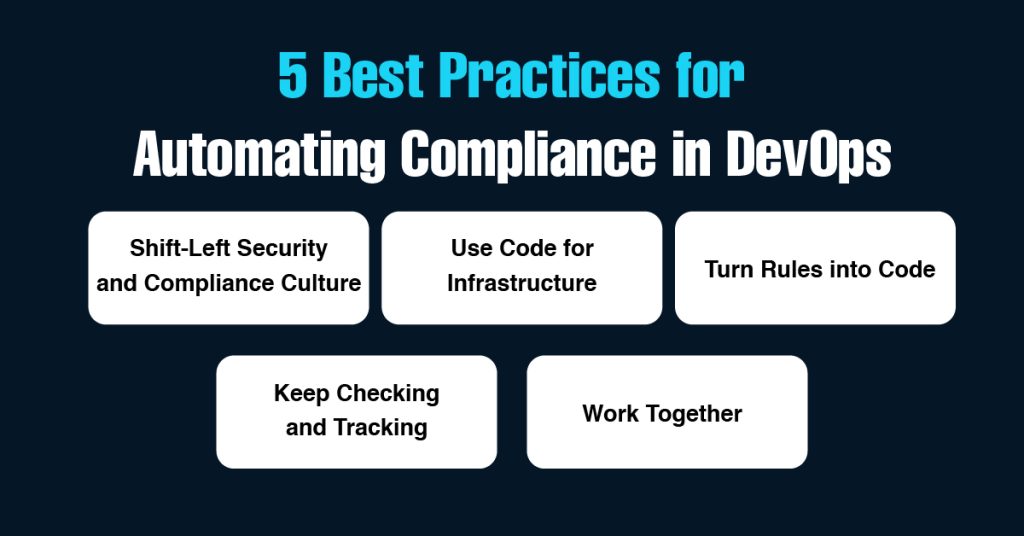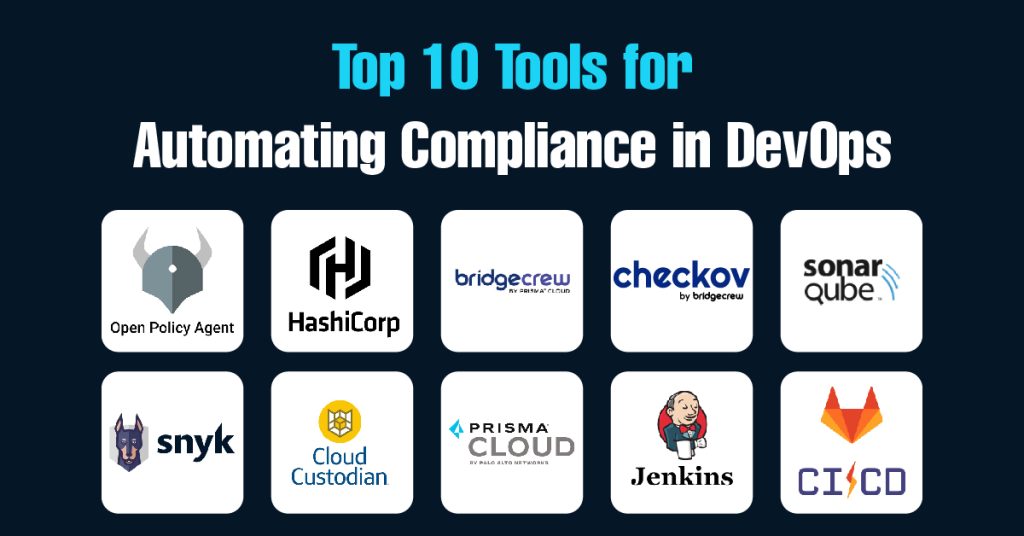Build, test, deploy—and comply. Learn how automating compliance in DevOps makes it seamless and scalable. Empower your DevOps team to deliver fast and stay secure!

Introduction
Software is not all about features and performance. It also has to deal with aspects like trust and security. We have seen a shrinkage in development cycles and the rise of deployments due to DevOps practices. This creates a challenge in keeping up with compliance requirements. Managing GDPR, HIPAA, SOC 2, ISO 27001, and internal policies is difficult. Traditional compliance policies are failing to match the speed and agility DevOps has to offer. This is where automation comes in!
Compliance in DevOps is about teamwork, not just tech. Everyone must care about security and rules. It’s not a last-minute task. Compliance is part of daily work. This keeps software safe and fast. Teams build trust and stay compliant.
This blog explains compliance automation in DevOps. We’ll cover why it’s vital, best practices, and top tools, and see how CI/CD fits in.
The Challenge? Compliance in a World of Rapid Change.
DevOps is about speed, agility, people working together, and continuous delivery. With its help, teams release software, comply with feedback quickly, and innovate.
- Manual Processes Slow Everything Down: Performing tasks like reviewing configurations, code scanning, etc., manually can take up so much of your time. It is more impractical when you have to perform these tasks multiple times daily.
- Increased Risk of Error: Human error is inevitable, especially under pressure. Manual checks miss out on essential compliance violations. This can lead to potential fines, data breaches, and reputational damage. An IBM and Ponemon Institute report showed that compliance failures can cause financial losses, averaging several million dollars.
- Lack of Visibility: Modern cloud systems have many small services and constantly change setups. It’s hard to keep track of your compliance using manual methods under such circumstances.
- Siloed Teams: Compliance and security teams used to work separately from development and operations. This creates handoffs, misunderstandings, and delays.
What Is Compliance Automation in DevOps?
Compliance automation uses innovative tools to keep software secure and rule-compliant. It eliminates tedious manual work. Instead of checking long lists by hand, automation runs checks as part of your DevOps process—no more waiting for stressful audits. Compliance becomes a natural part of your workflow.
Imagine it like a spell-checker in a word processor. You don’t finish a document and then hunt for typos. The tool highlights errors as you write. Compliance automation works the same way. It spots issues in your code, servers, or apps instantly. It checks security standards and regulations in real-time. This keeps your systems safe and compliant.
The big idea is to “shift left.” This means catching compliance problems early in the development cycle. Fix issues when developers write code, not just before release. Don’t wait for an audit to find mistakes. A 2024 Forrester report found that shifting left reduces compliance costs by 40%. Early fixes save time, money, and stress. Automation makes this possible for every team.
Key Features of Compliance Automation
- Integrated: Checks live inside your build and deploy pipeline. They aren’t a separate task.
- Automated: Scripts and tools do the work—no more manual steps.
- Continuous: Checks run often on every code change or schedule. You get feedback fast.
- Auditable: Every check and its result are logged. Audits become simple reports, not stressful hunts for evidence.
By building compliance into your workflow, you keep your DevOps speed and stay on the right side of security and regulation without slowing down your team.
The Automation Process in DevOps for Compliance
How to automate compliance in DevOps? Let us look at a typical automation process for DevOps compliance. It is not just a one-time process. It is a continuous and ongoing process. Here are the key steps in the automation process in DevOps for compliance:
Define Compliance Requirements and Policies
- Follow the rules and regulations (GDPR, HIPAA, SOC 2), industry standards, and security policies.
- Work with your security and legal teams to turn these into clear, actionable, testable policies.
Identify Automation Opportunities
- Review your current DevOps workflows and CI/CD pipeline.
- The spot where you can insert automatic policy checks. It can be during code commits, builds, tests, or deployments.
Implement Automated Compliance Checks
- Write scripts, use policy-as-code tools, or configure security scanners to run your defined checks.
- Ensure each check passes or fails based on your policy rules.
Integrate Checks into the CI/CD Pipeline
- Set these automated checks directly into your build, test, and deployment stages.
- Configure your pipeline to fail fast if a compliance check fails. Provide immediate feedback and prevent non-compliant changes from moving forward.
Automate Monitoring and Reporting
- Monitor your live environments, cloud infrastructure, applications, and containers for compliance drift.
- Automate compliance reports and dashboards that show your overall posture.
- Set up alerts so teams are notified immediately when something goes out of compliance in production.
Establish Feedback Loops and Iterate
- Make sure teams receive clear, timely feedback from automated checks.
- Use data and reports to refine policies, improve automation scripts, and guide team training.
- Review and update your automated checks as rules and standards change.
5 Best Practices for Automating Compliance in DevOps

If you are to automate DevOps compliance, it takes more than just selecting some tools. You must also have a set of practices that align with your DevOps culture. Here are some of the best practices for automating compliance in DevOps:
- Shift-Left Security and Compliance Culture: Everyone must understand their role in security and compliance, not just security or compliance teams. Create a supportive environment. Offer training and resources. Share compliance feedback with developers early in development to catch issues sooner.
- Use Code for Infrastructure: Write your infrastructure (like servers, networks, databases) as code using tools like Terraform. This makes it easy to repeat, test, and check. Check your code to make sure it follows security and compliance rules.
- Turn Rules into Code: Convert compliance rules into code using tools like Open Policy Agent. This lets you automatically enforce rules across your systems and apps.
- Keep Checking and Tracking: Don’t stop checking after setup. Use tools constantly to monitor if your systems follow compliance rules. Automatically collect logs and proof for compliance reports. This gives you real-time updates and makes audits simpler.
- Work Together: Connect developers, operations, security, and compliance teams. Share goals, tools, and knowledge about compliance. This teamwork is key to automating compliance and supports DevOps teamwork ideas.
Top 10 Tools for Automating Compliance in DevOps

A wide range of software tools can help you automate DevOps compliance. But which one is the best tool for you? The right tools for you will depend on- What kind of technology you use. What are your compliance requirements? What type of DevOps toolchain have you been using, etc.
Here are some of the best Tools for automating compliance in DevOps. They have been categorized by their key features and primary use cases:
| Tool | Key Features | Primary Use Case |
| Open Policy Agent (OPA) |
|
General-purpose policy engine for microservices, Kubernetes, APIs, etc. |
| HashiCorp Sentinel |
|
Specifically designed for HashiCorp ecosystem (Terraform, Vault, Nomad) |
| Bridgecrew |
|
Focuses on security and compliance checks for IaC (Terraform, CloudFormation, etc.). |
| Checkov |
|
Open-source tool for scanning IaC files against security and compliance policies |
| SonarQube |
|
Primarily used for SAST and identifying security vulnerabilities and code smells |
| Snyk |
|
Focuses on finding known vulnerabilities in open-source libraries and containers |
| Cloud Custodian |
|
Open-source engine for managing cloud environments based on policies and rules |
| Prisma Cloud (formerly Twistlock/Aqua Security) |
|
Comprehensive cloud-native security platform including CSPM, CIEM, CWPP. |
| Jenkins |
|
Highly extensible open-source automation server for building, testing, and deploying |
| GitLab CI/CD |
|
Integrated CI/CD platform within GitLab, offering various built-in security scanners |
What are the 5 Pillars of DevOps?
Compliance automation supports the 5 Pillars of DevOps in simple ways:
- Culture: It works best when developers, operations, security, and compliance teams collaborate and share responsibility.
- Automation: It’s the core! Automated compliance checks, reports, and fixes save time and ensure consistency.
- Lean: Automation removes slow manual tasks and rework from late compliance problems.
- Measurement: Automated checks give ongoing data to track compliance, spot trends, and report clearly.
- Sharing: Teams share compliance knowledge and duties through easy tools and automatic updates.
By using compliance automation, you make all 5 DevOps Pillars stronger, improving your overall process.
Ready to elevate your DevOps knowledge?
Ready to grow your DevOps skills? Learning how to automate compliance is super essential for IT folks today. It helps you work smarter in fast-moving tech teams and huge companies. Want to get better at DevOps? Check out ValueX2 for excellent training courses.
They have a SAFe DevOps course and certification perfect for learning how to mix security, compliance, and other key practices into a speedy, flexible system. This course helps you understand how automating compliance in DevOps makes work seamless in large teams so everyone stays on track. Head to ValueX2 to explore their classes and take a big step forward in your career. Start today and grow your skills!
Conclusion
Today’s software world moves super fast and can be tricky. Old-school, manual compliance checks slow things down, lead to mistakes, and make things risky. Automating compliance in DevOps is a game-changer for companies that want to create new ideas quickly while keeping everything safe and following the rules.
Compliance automation turns a tough job into something that helps you deliver software faster, safer, and better. It reduces risks, saves time, and makes you feel confident that your systems are solid. Embracing automation is like giving your team a superpower for building great software with less worry.
Frequently Asked Questions about Automating Compliance in DevOps
Is compliance automation only for big companies?
Ans. No, it helps companies of all sizes. For example, healthcare or finance startups need compliance as automation lowers risks for everyone. It makes DevOps workflows smoother. It helps many companies save time and effort.
How do I start automating compliance in DevOps?
Ans. Take small steps to begin. Pick one or two key compliance rules. Focus on your primary application or system. Start with one part of your pipeline. Perform code checks and infrastructure scans. Test and learn from the process. Slowly add more automated checks over time.
What’s the biggest challenge in compliance automation?
Ans. The challenge isn’t just about tools. Compliance rules can be unclear or vague. Turning them into clear tests is tough. Developers, operations, and security teams must collaborate. They need to agree on what the rules mean. Building automation takes teamwork and effort.
Does automation replace human auditors?
Ans. No, automation doesn’t replace auditors. It makes their jobs much easier. Automation gives evident proof of compliance. It provides consistent data every time. Auditors can check these automated processes. They focus on tricky areas that automation can’t cover. This saves time for everyone.
What compliance frameworks can automation support?
Ans. Automation works for many compliance frameworks. You can turn rules into automated checks. For example, use NIST or GDPR guidelines. Automation helps verify standards like HIPAA or SOC 2. It also supports ISO 27001 and PCI DSS. Continuous checks keep your systems compliant.

Bhavna is an Agile Coach and Consultant with over a decade of experience in advisory, corporate finance, IT assurance, and operations at Big 4 and within the industry in the UK and India. She has recently been the CEO of a start-up where she implemented agile practices within HR, Marketing, and Product teams.
She is also a SAFe® Practice Consultant (SPC) and authorized instructor for ICAgile Agility in HR (ICP-AHR), Agility in Marketing (ICP-MKG), and Business Agility Foundations (ICP – BAF) training courses. She provides training for agile transformation to corporate, public, and private batches, as well as consulting for enterprise agile transformation.






